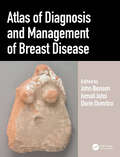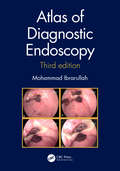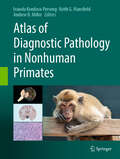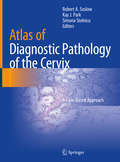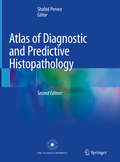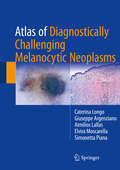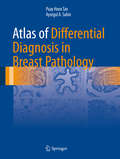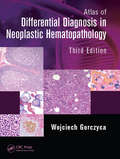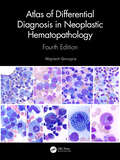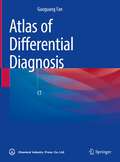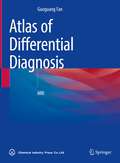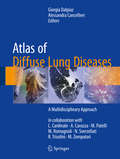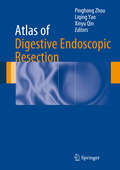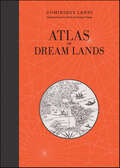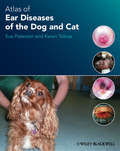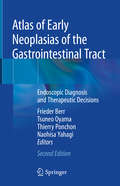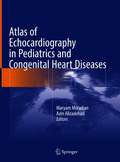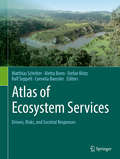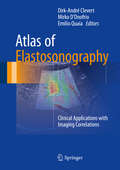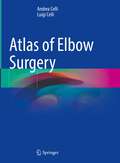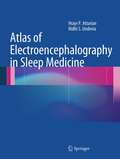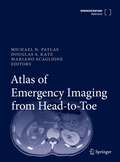- Table View
- List View
Atlas of Diagnosis and Management of Breast Disease
by Ismail Jatoi Edited By John R. Benson Dorin DumitruThis atlas focuses on the principles of diagnosis and management of breast diseases with a target audience of trainees and junior consultants in gynaecology, together with SAS grade doctors, advanced care practitioners, and specialist nurses.Key Features: Provides an expert guide to the range of breast problems presenting for the gynaecologist Offers a reliable summary of the possible diagnoses and follow-up management procedures involved Guides the front-line clinician with the information to manage and advise patients with confidence
Atlas of Diagnostic Endoscopy, 3E
by Mohammad IbrarullahThis book is a compilation of endoscopic images of the upper gastrointestinal tract. The 3rd edition is enriched with high-resolution digital images highlighting the classification and staging of endoscopically relevant diseases. Serial documentation of diseases and procedures like corrosive injury, variceal obliteration, peptic ulcer etc. provides a complete, informative and interesting perspective. Rare conditions like Dieulafoy’s disease and Gastric antral vascular ectasia (GAVE) have been extensively discussed along with common diseases of the GI tract. This book outlines the technique and interpretation of endoscopic images proving to be a helpful guide to endoscopy practitioners. Key Features Explores various GI tract diseases through coloured, high resolution clinical photographs. Serves as a useful reckoner for trainee endoscopists and practitioners pursuing gastroenterology or gastrointestinal endoscopy. The text is updated with tables, flowcharts, classifications and international treatment guidelines.
Atlas of Diagnostic Pathology in Nonhuman Primates
by Andrew D. Miller Ivanela Kondova-Perseng Keith G. MansfieldThe Atlas of Diagnostic Pathology in Nonhuman Primates offers the first extensively illustrated collection of classic lesions in nonhuman primate diseases and pathological conditions, compiled by an international team of expert contributors. Organized by infectious and noninfectious conditions, the atlas comprehensively covers viral, bacterial, fungal, and parasitic diseases, as well as nutritional, toxic, and metabolic causes, and genetic, age-related, neoplastic, and noninfectious inflammatory conditions. Since nonhuman primates are an indispensable resource for efficacy and safety evaluation of novel therapeutic strategies targeting clinically important human diseases, research with monkeys is critical to understand how to prevent and treat emerging infectious diseases such as Zika virus disease, Ebola, Middle East Respiratory Syndrome (MERS), COVID-19/SARS-CoV-2/coronavirus, pandemic flu, and many more. This book is intended to serve veterinary practitioners in university facilities, zoos, biotechnological and pharmaceutical companies, as well as clinicians, researchers, and students engaged in nonhuman primate research.
Atlas of Diagnostic Pathology of the Cervix: A Case-Based Approach
by Robert A. Soslow Simona Stolnicu Kay J. ParkThis book provides a practical guide to the diagnosis of cervical lesions. Chapters detail recent changes to diagnostic criteria and classification and the impacts these developments have on patient management. The anatomy and histology of the cervix are discussed, along with macroscopic and microscopic changes, prognostic and predictive parameters, epidemiological data, and staging systems. Atlas of Diagnostic Pathology of the Cervix: A Case-Based Approach utilizes diagnostic algorithms and highlights to offer readers appropriate management criteria and aims to give trainees, practicing pathologists, and gynecologists a case-based approach to the treatment of cervical lesions.
Atlas of Diagnostic and Predictive Histopathology
by Shahid PervezThe second edition of this atlas covers the histopathology of all organ systems, supporting trainees and residents in the histopathological diagnosis of a wide range of inflammatory, neoplastic, degenerative, developmental and metabolic disorders. Though organ-specific books and atlases are increasingly available, there is a growing demand for a comprehensive guide to the histopathological diagnosis of each organ system, enabling histopathology trainees/residents and general pathologists to make reliable provisional or final diagnoses in routine practice. Each chapter covers a specific organ system and provides a better understanding of the microscopic pathology of common diseases and cancers, their interpretation, clinical presentation, epidemiology and demographics. The book also includes a chapter on ‘Predictive Pathology’ to help pathologists and other medical and healthcare professionals understand histopathology and report on it in keeping with standard international guidelines for individualized patient management. Intended as a concise and handy guide, this book offers a ready reference for trainees in histopathology, surgical pathology, anatomic pathology and cellular pathology, as well as practicing pathologists. It can also serve as a useful resource for biologists, biomedical scientists and physicians in general. The book features over 2200 illustrations with microscopic descriptions and interpretations. Besides H&E, special stains, IHC, FISH and radiology are included.
Atlas of Diagnostically Challenging Melanocytic Neoplasms
by Caterina Longo Giuseppe Argenziano Aimilios Lallas Elvira Moscarella Simonetta PianaThis atlas provides a clear, concise overview of the most challenging circumstances faced by clinicians and pathologists when dealing with melanocytic neoplasms. The book is structured as a case series; for each case, the clinical and dermoscopic appearances are presented, accompanied by a brief but comprehensive description and compelling histopathologic images. When available, in vivo confocal microscopy images are also included to highlight additional diagnostic clues. Identification of key messages and selected references will further guide the reader in the diagnosis and management of the neoplasm under consideration. It is well known that melanocytic lesions can be difficult to interpret. Some lesions show an ambiguous combination of morphologic criteria, and in these cases interpretation entails a high degree of subjectivity that results in low interobserver agreement even among expert pathologists. This atlas demonstrates how the addition of clinical information, including that provided by dermoscopy, can assist in reaching a more confident diagnosis.
Atlas of Differential Diagnosis in Breast Pathology (Atlas of Anatomic Pathology)
by Puay Hoon Tan Aysegul A. SahinThis atlas illustrates the range of breast lesions with detailed correlation of gross and microscopic features. Where relevant, radiological images are incorporated. A description of normal, developmental and physiological breast morphology will serve as introduction to the main content of this atlas. Classification of tumors is based on the latest World Health Organization Classification of Tumors of the Breast, 4th edition, 2012. As immunohistochemistry is a key adjunctive tool in the workup of breast lesions as well as used in prognostic evaluation of breast cancers, appropriate examples are interspersed among the lesions where pertinent.
Atlas of Differential Diagnosis in Neoplastic Hematopathology
by Wojciech GorczycaManagement of tumor patients now relies on new individualized approaches to treatment, requiring extensive knowledge of the molecular makeup of tumors. Updated and expanded, the third edition of Atlas of Differential Diagnosis in Neoplastic Hematopathology examines not only the differential diagnosis but also the detailed morphologic, immunophenoty
Atlas of Differential Diagnosis in Neoplastic Hematopathology
by Wojciech GorczycaThis atlas presents not only the differential diagnosis but also the detailed morphologic, immunophenotypic, and especially genetic characteristics of the majority of hematolymphoid malignancies. An expert hematopathologist here provides a valuable resource to understand, use, or interpret one or more of these diagnostic modalities with confidence. This new edition has a compact format with up-to-date information - especially on genetic aspects - and will be an indispensable reference for all professionals in the specialty. *Provides an unrivalled visual resource for differential diagnosis in neoplastic hematopathology *Enables specialist and trainee oncologists and pathologists alike to understand, use, and interpret diagnostic modalities with confidence *Supplies quick access to information via tables, algorithms, and composite figures
Atlas of Differential Diagnosis: CT
by Guoguang FanAiming to equip readers with the knowledge required for accurate and timely diagnosis, this book presents illustrative cases that address a broad spectrum of clinical problems, including frequent, uncommon and rare diseases of brain, head and neck, spine, musculoskeletal system, chest and abdomen. To make readers understand easily, tips in differential diagnosis are summarized in the table, accompanying with typical images and key teaching points. It will be a valuable resource for diagnostic radiologists, residents, fellows, and related clinical doctors.
Atlas of Differential Diagnosis: MRI
by Guoguang FanAiming to equip readers with the knowledge required for accurate and timely diagnosis, this book presents illustrative cases that address a broad spectrum of clinical problems, including frequent, uncommon and rare diseases of brain, head and neck, spine, musculoskeletal system, chest and abdomen. To make readers understand easily, tips in differential diagnosis are summarized in the table, accompanying with typical images and key teaching points. It will be a valuable resource for diagnostic radiologists, residents, fellows, and related clinical doctors.
Atlas of Difficult Gynecological Surgery
by Anirudha Rohit Podder Jyothi G SeshadriCovering various difficult surgeries encountered in daily gynecological practice and providing unique insights into operative gynecology, this atlas offers an essential learning guide for gynecologists. Standard gynecological surgeries may turn out to be extremely complex on the operating table; this atlas demonstrates how the operating gynecologist can manage such procedures successfully without causing any injuries. For each surgery, it includes a series of color photographs accompanied by descriptive step by step notes, explaining to the readers the surgical steps and the problems that might occur if the dissection is not performed correctly. Helping readers understand and visualize the textbook descriptions of gynecological surgeries, the atlas offers a valuable resource for postgraduate students and fellows of obstetrics and gynecology, as well as senior practicing gynecologists, urologists and surgeons.
Atlas of Diffuse Lung Diseases: A Multidisciplinary Approach
by Giorgia Dalpiaz Alessandra CancellieriThis atlas is designed as an easy-to-use reference guide that identifies and illustrates the key patterns of diffuse lung diseases observed on high-resolution computed tomography (HRCT) and then documents in more detail the characteristics and appearances of the individual diseases, grouped on the basis of their prevalent pattern. A further feature of the book is its interdisciplinary nature: contributions from experts in various specialties are tightly interwoven throughout and many pathologic correlations are included. Less experienced readers will find that this atlas, with its wealth of figures and helpful color coding, steers them towards correct interpretation when confronted by the multiplicity and complexity of these diseases; those who are already experts, on the other hand, will benefit from the detailed coverage of individual diseases, which will deepen their understanding. At the end of the book, a graphically appealing and practice-oriented illustrated glossary with tips and tricks offers a further highly effective educational tool. Given the clinical spectrum of diseases covered, this atlas will prove invaluable for a wide range of healthcare workers, especially radiologists, pulmonologists, and pathologists.
Atlas of Digestive Endoscopic Resection
by Pinghong Zhou Liqing Yao Xinyu QinDigestive Endoscopic Resection provides a minimally invasive method of diagnosing and treating gastrointestinal cancer. This book contains a comprehensive and detailed introduction to this technique. It includes preoperative preparation, surgical methods, intraoperative complications and postoperative management of advanced endoscopic procedures. It mainly focuses on endoscopic submucosal dissection (ESD) and endoscopic submucosal tunneling technologies, such as peroral endoscopic myotomy (POEM) and submucosal tunneling endoscopic resection (STER). This book presents essential surgical steps and diagnostic illustrations of these fast developing techniques. It provides a theoretical basis and valuable technical guidance for experts to perform ESD and summarizes this new treatment of gastrointestinal disease not only early cancers but also other gastrointestinal disorders including esophageal achalasia, etc. The Atlas of Digestive Endoscopic Resection will serve as an ideal reference for physicians and surgeons involved in endoscopic minimally invasive surgery. Editors Pinghong Zhou, Liqing Yao and Xinyu Qin are professors at Zhongshan Hospital affiliated to Fudan University, Shanghai, China.
Atlas of Dream Lands (Atlas Series)
by Dominique LanniA keepsake collection of maps depicting legendary and real places for the lover of literature, history, and cartography. This exploration of the "Mythical Elsewhere" explores a wide array of places, from the well known to the obscure, through the eyes of historians, explorers, conquerors, and writers across the ages. Lose yourself in the past as you travel to such destinations as Troy, the Mughal Empire, the Congo, the river Nile, El Dorado, and many more across the globe:Europe: Candia, Kythira, Ogygia, TroyAsia: Cathay, Cipangu, Colchis, the Mughal Empire, Golconda, Kafiristan, the Land of the Cimmerians, Taprobana, TartaryAfrica: Barbary Coas, Cape Bojador, Congo, Meroë, Mutapa, the Land of the Mangbetu, Prester John&’s Kingdom, the Kingdom of Saba&’, the Source of the River Nile, the Lands of Good HopeThe Americas: Araucanía, Cibola, El Dorado, the Land of the Amazons, Tierra del FuegoSouthern Lands: New Cythera, Terra Australis the Edge of the World: the Isles of the Blessed, the Garden of the Hesperides, Lemuria, Thule Accompanied by this unique atlas and the great explorers of antiquity and Renaissance as well as poets, scholars, and novelists of all eras, readers will embark on a poetic exploration of the world. Let such greats as Herodotus, Marco Polo, Christopher Columbus, and Heinrich Schliemann be your guide on this journey to dreamlike places that are sometimes imagined and imaginary but, to those who believe, always &“perfectly real.&”? It's a trip you will never forget.
Atlas of EEG in Critical Care
by Richard Brenner Lawrence HirschAs the population ages, technology improves, intensive care medicine expands and neurocritical care advances, the use of EEG monitoring in the critically ill is becoming increasingly important.This atlas is a comprehensive yet accessible introduction to the uses of EEG monitoring in the critical care setting. It includes basic EEG patterns seen in encephalopathy, both specific and non-specific, nonconvulsive seizures, periodic EEG patterns, and controversial patterns on the ictal-interictal continuum. Confusing artefacts, including ones that mimic seizures, are shown and explained, and the new standardized nomenclature for these patterns is included.The Atlas of EEG in Critical Care explains the principles of technique and interpretation of recordings and discusses the techniques of data management, and 'trending' central to long-term monitoring. It demonstrates applications in multi-modal monitoring, correlating with new techniques such as microdialysis, and features superb illustrations of commonly observed neurologic events, including seizures, hemorrhagic stroke and ischaemia.This atlas is written for practitioners, fellows and residents in critical care medicine, neurology, epilepsy and clinical neurophysiology, and is essential reading for anyone getting involved in EEG monitoring in the intensive care unit.
Atlas of Ear Diseases of the Dog and Cat
by Sue Paterson Karen M. TobiasBringing together a wealth of images of normal and diseased dog and cat ears, this is an indispensible diagnostic tool for the small animal veterinary practitioner seeing ear cases on a regular basis. This fully illustrated atlas covers the anatomy of the canine and feline ear, diagnostic techniques, a range of commonly seen diseases, and ear surgery.Atlas of Ear Diseases of the Dog and Cat is one of the most complete picture references for this rapidly expanding branch of small animal medicine and surgery. It is an invaluable aid for general practitioners, as well as those specialising in dermatology, and serves as an effective revision aid for veterinary students and those studying for further qualifications in veterinary dermatology.Includes over 400 high quality colour clinical images and clear line drawingsImages are accompanied by clear explanatory text throughoutEnables veterinarians to match cases seen in practice with photos supplied to aid diagnosisWritten by highly qualified specialist veterinary dermatologist and veterinary surgeon
Atlas of Early Modern Britain, 1485-1715
by Christopher DaniellThe Atlas of Early Modern Britain presents a unique visual survey of British history from the end of the Wars of the Roses through to the accession of George I in 1715. Featuring 117 maps, accompanied throughout by straightforward commentary and analysis, the atlas begins with a geographical section embracing England, Scotland, Ireland and Wales and providing clear orientation for the reader. It then focuses separately on the sixteenth and seventeenth centuries, dividing its coverage of each into four key themes: Geography and Counties - Outlining in detail how Britain's geography was shaped during the period; Politics and War - the main campaigns, rebellions and political changes in each century; Religion - including denominational concentrations, diocesan boundaries and witch trials; Economy and Culture -charting Britain's wealthiest towns, the locations of Britain's houses of aristocracy and the effects of The Great Fire of London; The broad scope of the atlas combines essential longer-term political, social, cultural and economic developments as well as key events such as the Spanish Armada, the Dissolution of the Monasteries, the Civil War and the Glorious Revolution. Its blend of clear visual aids and concise analysis represents an indispensable background and reference resource for all students of the early modern period.
Atlas of Early Neoplasias of the Gastrointestinal Tract: Endoscopic Diagnosis And Therapeutic Decisions
by Frieder Berr Tsuneo Oyama Thierry Ponchon Naohisa YahagiThe latest edition of this text provides a comprehensive update on the current standards and newest skills in diagnostic endoscopy for pre/neoplastic lesions of the upper and lower gastrointestinal tract. The atlas outlines procedural requirements and strategies for detection and endoscopic staging (prediction of pT category) of small and minute early cancers, and presents endoscopic and high-resolution endosonographic criteria for submucosal invasiveness. The three major resection techniques, including risk profiles, and differential indications and contraindications for each technique are also outlined. In addition to thoroughly revised chapters from the previous edition, the atlas features new content on submuscosal neoplasias in the GI tract, new magnifying images of early gastric neoplasias, and new endoscopic images of adenoma, dyplasia, inflammatory bowel disease, and early cancer in the duodenum and small bowel. <P><P> Written by experts in the field, Atlas of Early Neoplasias of the Gastrointestinal Tract: Endoscopic Diagnosis and Therapeutic Decisions, Second Edition is a valuable resource that will improve the diagnostic skills of endoscopists.
Atlas of Echocardiography in Pediatrics and Congenital Heart Diseases
by Azin Alizadehasl Maryam MoradianThis atlas provides a practical guide to the diagnosis of congenital heart disease using echocardiography in both adults and children. A plethora of high-quality echocardiography images provide practical examples of how to diagnose a range of conditions correctly, including aortic stenosis, tricuspid atresia, coronary artery fistula and hypoplastic left heart syndrome. Atlas of Echocardiography in Pediatrics and Congenital Heart Diseases describes the diagnostic management of a range of congenital heart diseases successfully in both adults and children. Therefore it provides a valuable resource for both practicing cardiologists who regularly treat these patients and for trainees looking to develop their diagnostic skills using echocardiography.
Atlas of Ecosystem Services: Drivers, Risks, And Societal Responses
by Aletta Bonn Matthias Schröter Cornelia Baessler Stefan Klotz Ralf SeppeltThis book aims to identify, present and discuss key driving forces and pressures on ecosystem services. Ecosystem services are the contributions that ecosystems provide to human well-being. The scope of this atlas is on identifying solutions and lessons to be applied across science, policy and practice. The atlas will address different components of ecosystem services, assess risks and vulnerabilities, and outline governance and management opportunities. The atlas will therefore attract a wide audience, both from policy and practice and from different scientific disciplines. The emphasis will be on ecosystems in Europe, as the available data on service provision is best developed for this region and recognizes the strengths of the contributing authors. Ecosystems of regions outside Europe will be covered where possible.
Atlas of Elastosonography: Clinical Applications with Imaging Correlations
by Emilio Quaia Dirk-André Clevert Mirko D’onofrioWith the aid of an extensive series of high-quality images, this atlas describes all the potential applications of elastosonography in routine clinical practice. After a brief introduction on technical and physical aspects, the diagnostic benefits of elastosonography in a range of settings are illustrated with the aid of numerous representative cases. The coverage encompasses pathologies of the liver, spleen, pancreas, kidney, breast, thyroid, testis, musculoskeletal system, and vascular system. In addition, helpful correlations with imaging appearances on ultrasound and computed tomography are included. Elastosonography is a powerful, relatively new diagnostic technique that assesses the elasticity of tissues as an indicator of malignancy. Readers will find this book to be an excellent aid to use and interpretation of the technique.
Atlas of Elbow Surgery
by Andrea Celli Luigi CelliThis richly illustrated atlas is entirely devoted to the most modern surgical techniques of the elbow, offering a comprehensive, step-by-step and detailed examination of all the technical aspects of the surgical exposure of this joint. With the help of over 100 original drawings and photographs, it offers readers a unique understanding of elbow anatomy and surgical approaches, providing precise indications and surgical timing for clinical practice. An entire section focuses on the surgical management of the most common diseases of the elbow: the surgical exposures are related to pathologies affecting the lateral medial, anterior and posterior compartments of the elbow. This atlas will be of great value both to trainees and to specialists who manage disorders of the elbow, including orthopedic surgeons, traumatologists, and sports physicians, as well as anatomists.
Atlas of Electroencephalography in Sleep Medicine
by Nidhi S Undevia Hrayr P. AttarianSleep Medicine is a field that attracts physicians from a variety of clinical backgrounds. As a result, the majority of sleep specialists who interpret sleep studies (PSG) do not have specialized training in neurophysiology and electroencephalography (EEG) interpretation. Given this and the fact that PSGs usually are run at a third of the speed of EEGs and that they usually have a limited array of electrodes, waveforms frequently appear different on the PSGs compared to the EEGs. This can lead to challenges interpreting certain unusual looking activity that may or may not be pathological. This Atlas of Electroencephalograpy in Sleep Medicine is extensively illustrated and provides an array of examples of normal waveforms commonly seen on PSG, in addition to normal variants, epileptiform and non-epileptiform abnormalities and common artifacts. This resource is divided into five main sections with a range of topics and chapters per section. The sections cover Normal Sleep Stages; Normal Variants; Epileptiform Abnormalities; Non-epileptiform Abnormalities; and Artifacts. Each example includes a brief description of each EEG together with its clinical significance, if any. Setting the book apart from others in the field is the following feature: Each EEG discussed consists of three views of the same page -- one at a full EEG montage with 30mm/sec paper speed, the same montage at 10mm/sec (PSG speed) and a third showing the same thing at 10 mm/sec, but with the abbreviated PSG montage. Unique and the first resource of its kind in sleep medicine, the Atlas of Electroencephalograpy in Sleep Medicine will greatly assist those physicians and sleep specialists who read PSGs to identify common and unusual waveforms on EEG as they may appear during a sleep study and serve as a reference for them in that capacity.
Atlas of Emergency Imaging from Head-to-Toe
by Mariano Scaglione Douglas S. Katz Michael N. PatlasThis reference work provides a comprehensive and modern approach to the imaging of numerous non-traumatic and traumatic emergency conditions affecting the human body. It reviews the latest imaging techniques, related clinical literature, and appropriateness criteria/guidelines, while also discussing current controversies in the imaging of acutely ill patients. The first chapters outline an evidence-based approach to imaging interpretation for patients with acute non-traumatic and traumatic conditions, explain the role of Artificial Intelligence in emergency radiology, and offer guidance on when to consult an interventional radiologist in vascular as well as non-vascular emergencies. The next chapters describe specific applications of Ultrasound, Magnetic Resonance Imaging, radiography, Multi-Detector Computed Tomography (MDCT), and Dual-Energy Computed Tomography for the imaging of common and less common acute brain, spine, thoracic, abdominal, pelvic and musculoskeletal conditions, including the unique challenges of imaging pregnant, bariatric and pediatric patients. Written by a group of leading North American and European Emergency and Trauma Radiology experts, this book will be of value to emergency and general radiologists, to emergency department physicians and related personnel, to obstetricians and gynecologists, to general and trauma surgeons, as well as trainees in all of these specialties.
